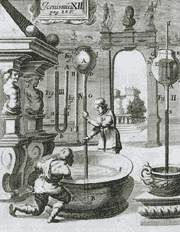|

Torricellian
Experiment.
Gaspar Schott, Technica curiosa, sive, Mirabilia artis, Würzburg
1664
|
The barometer is the instrument
which lets us "weigh" air. It works in much the same way as a set
of scales: the column of mercury is counter-balanced by the pressure
of air on a bowl full of mercury.
Torricelli
discovered in 1644
that the level of mercury contained in a tube closed at one end, tipped
upside down and lowered into a bowl of mercury, went down only partially
because it was counter-balanced by the pressure of air on the mercury
in the bowl. He also discovered that the height of the column of mercury
varied, at the same altitude, with variations in temperature. Thanks
to this discovery, it was possible to perfect the mercury thermometer.
At sea level, at 0°C and at a latitude of 45, the level of mercury
in the little column stays at around 76 cm, whereas on top of a 2,500
m mountain, it settles at only 57 cm.
|

